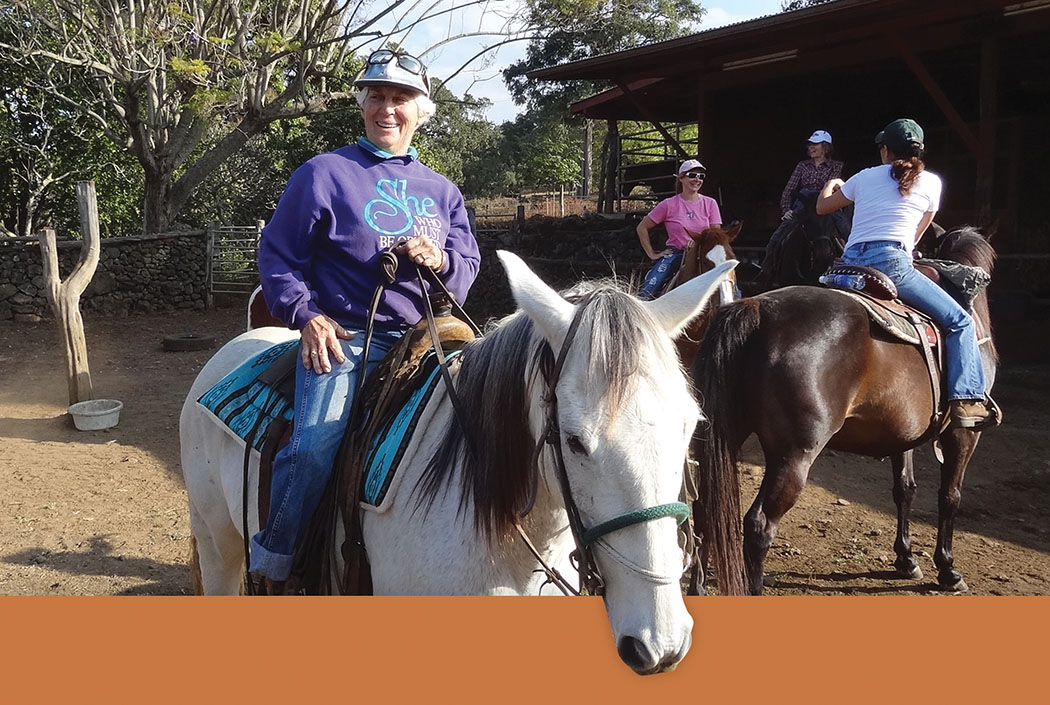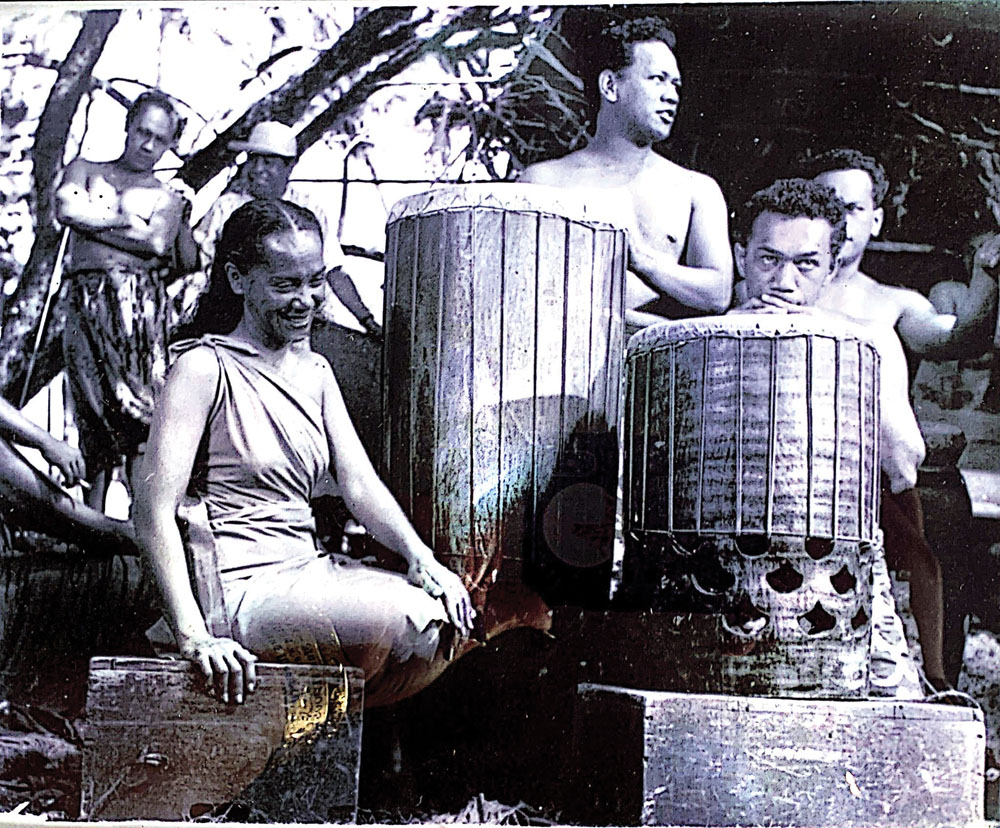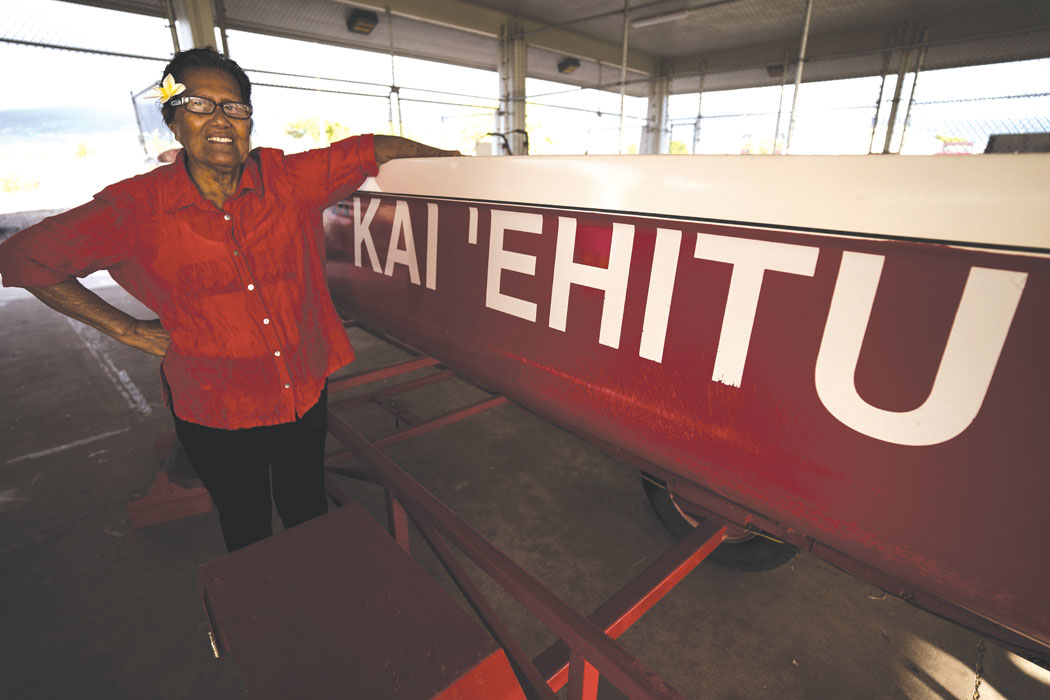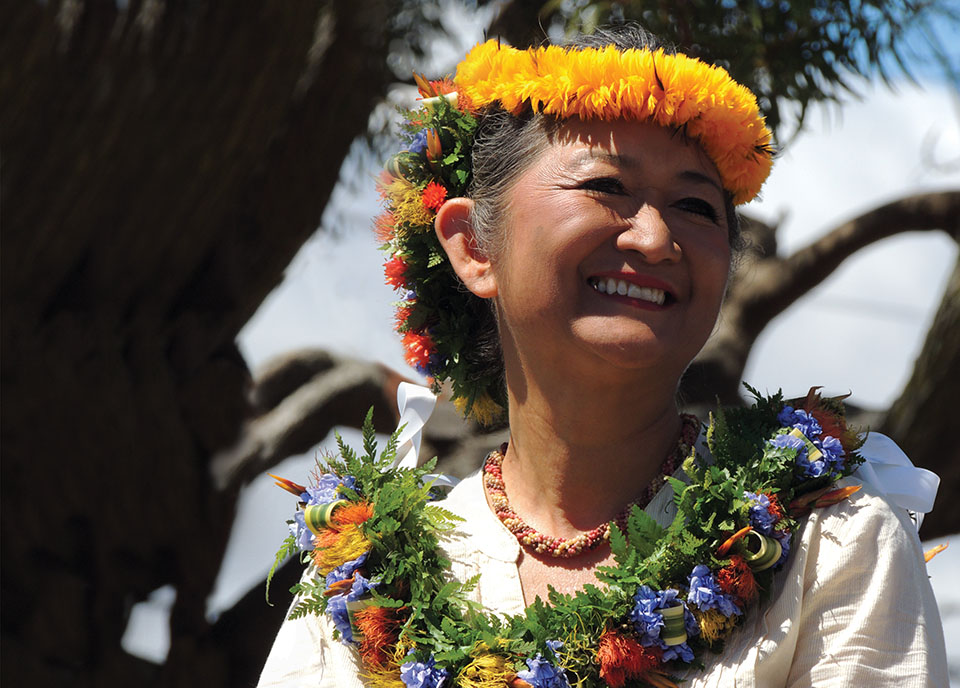
What it’s Like to be Pā‘ū Queen

By Denise Laitinen
It’s very humbling to be asked to be a pā‘ū queen,” says Anna Akaka, Pā‘ū Queen of the 2013 King Kamehameha Day Kona parade. Anna, the wife of Danny Akaka, Cultural Advisor for the Mauna Lani Bay Hotels and Bungalows, and daughter-in-law of retired Senator Daniel Akaka, says being named pā‘ū queen comes with tremendous responsibility.
“I think that every young girl [in Hawai‘i] that watches the pā‘ū riders in a parade is amazed at the pageantry,” Anna says.
Every year, Barbara Nobriga, parade chairperson and respected expert on pā‘ū riding, selects the parade’s pā‘ū queen and the island princesses. Barbara says the selection process differs for pā‘ū queen versus a pā‘ū princess. However, all those selected must be excellent riders.
Island princesses must also be 18 or older and part Hawaiian.
The pā‘ū queen must also be part Hawaiian, and usually, although not always, has experience being a pā‘ū princess.
“It used to be that after you rode all eight islands [as princess], you got to ride queen,” says Barbara. “Now things have changed. I don’t have any one person who has ridden all eight islands yet, so I go out to the community and select a queen that represents us well.”
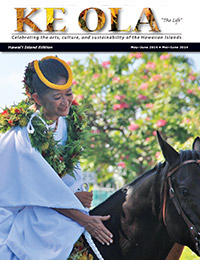
Last year, Barbara asked Anna to be pā‘ū queen. The parade became a family affair with her father-in-law, retired Hawai‘i Senator Daniel Akaka, serving as the parade’s grand marshall and her husband and children riding in her unit.
And while the Senator’s role as grand marshal may have been ceremonial, Anna’s role as pā‘ū queen was not.
Anna points out that the pā‘ū queen is responsible for every aspect of each of the eight pā‘ū riding units, as well as funding it. Working together, the queen and the princesses are responsible for putting the units together, including the creation of the riding unit, the horses, creating their clothing, hairpieces, lei, lauhala stand, and the horses’ lei.
Anna notes that more than 100 people were involved in helping with the preparations for just the queen’s unit alone.
“What happened was it became a strong community effort,” says Anna. “We had friends and family that stepped forward to help.”
Becoming a pā‘ū queen is not something that you can ask Google. There are no pā‘ū queen instruction books on how to be a pā‘ū queen at the local Walmart.
It is information, history, and knowledge handed down through generations by people who perpetuate Hawaiian culture.
“The Nobrigas were instrumental in providing training on [pā‘ū riding] protocol and how we were to assemble ourselves,” says Anna.
About two months before every annual parade, Barbara Nobriga teaches a workshop on pā‘ū riding protocol for the princesses and queen.
Anna also sought out the advice and guidance of well-known pā‘ū riders and former queens.
“Granny Stella Ka‘au‘a Akana comes from an iconic ranching family,” says Anna, describing one of the kupuna she sought advice from. “Aunty Barbara Nobriga, Queenie Dawson, Aunty Mona Teves, Hannah Springer…they helped me to understand what would be proper to use for adornment and protocol.”
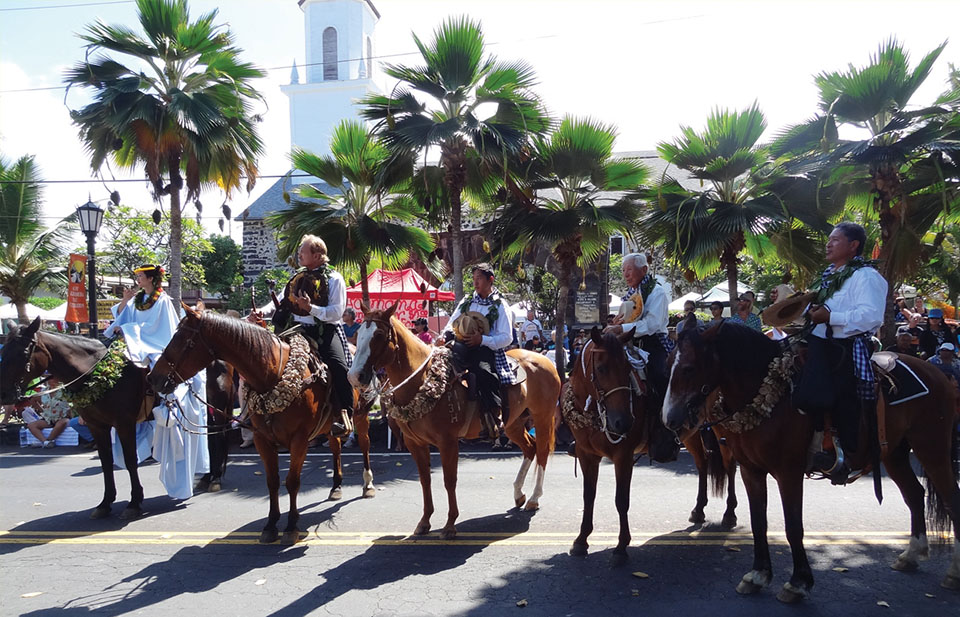
Anna points out that there are many aspects to being a pā‘ū queen. “Part of it is the protocol, the role you accept as pā‘ū queen,” and there are other important considerations as well.
“Not only do you have to show the fine horsemanship of the former pā‘ū riders,” explains Anna, “You also have to acknowledge those who have come to honor you along the parade route. All the way from kupuna to keiki, you need to acknowledge those who have come to watch you in the parade.”
Anna notes that while she learned a lot about pā‘ū riding protocol through workshops and volunteering in parades, some of the needed skills come from a being immersed in Hawaiian life.
“In the Kona parade my husband was my chanter. The chant that he composed as we presented our ho‘okupu (offering) at Hulihe‘e Palace honored my family, his family, and our family combined, as well as the elements of nature that our families are tied to. That was a very special chant of our family. It acknowledged our chiefly ancestors that our family descended from. Those are the kinds of things that are a lifetime of training.”
It is that lifetime of learning that prepares a pā‘ū queen for any situation that may arise. Anna describes a spontaneous event that occurred during last year’s parade.
“We had friends attending the parade who didn’t know we were in it,” she explains. “These folks are chanters for Merrie Monarch [hula competition]. When they saw us in the parade, they broke into chant.
“It was very spontaneous. It was such an honor,” continues Anna.
She responded in oli (chant) as well, acknowledging them by the importance of the nature in the district in which they live.
It is not enough that the queen have the skill to compose an original chant, prepare a ho‘okupu, and possess the ability to instantaneously respond in Hawaiian with a chant specific to the natural elements found in the chanter’s district of origin, she must also be an accomplished equestrian, know how to gather and make lei, and prepare her own costume.
The Horses
A pā‘ū queen must first and foremost be a good equestrian. As head of the parade’s pā‘ū units, Barbara Nobriga personally verifies the riding skill of the queen and each princess in the parade.
It’s not just the skill of the rider that’s important; the horses also need to be able to deal with riding in public.
“There are working horses and there are parade horses,” says Anna.
“Parade horses need to be accustomed to being on roadways, being around other animals, as well as the sounds of people, the wind, the air, and the surf.”
Not every pā‘ū princess or queen has a horse capable of being a parade horse.
“Aunty Barbara did a great job of acquiring horses,” says Anna of last year’s parade.
“It’s a tricky situation finding people who will loan you their beloved horse to ride in a parade.
“For most people their horses are part of their family. They might not be so willing to lend you their baby unless they know you very well and know how well you can ride.”
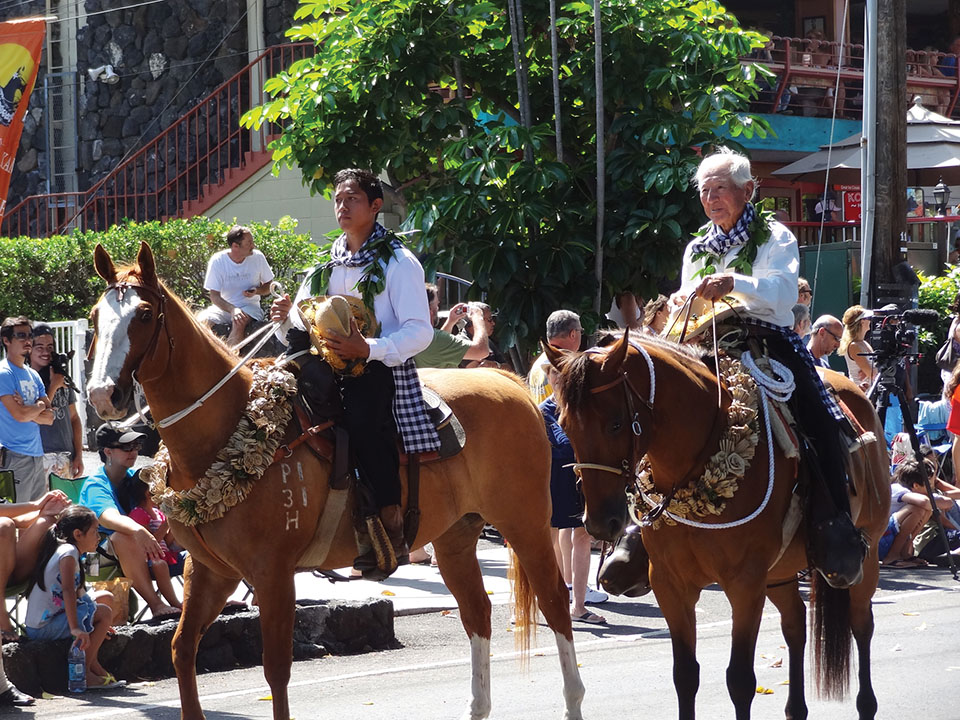
The Pā‘ū
When it comes to the pā‘ū costume, Anna says every parade is different. The princesses must wear the colors of the island they represent. The pā‘ū queen has more latitude in choosing her colors and fabric. According to Barbara, the pā‘ū queen can choose colors to represent the land of her birth. The type of fabric is also at the queen’s discretion.
“It depends on whether each unit buys their own fabric,” says Anna. “In the Kona parade, Aunty Barbara provides pā‘ū for the queen and two of her attendants, as well as each princess and two attendants.”
“The pā‘ū that were provided [for Kailua-Kona] were all white. That left us with an open palette for the floral lei.”
However, when Anna rode as pā‘ū queen in the 2013 Paniolo Parade in Waimea last October, she went to famed Hawaiian clothing designer Sig Zane for help.
“Sig Zane actually created my pā‘ū for me,” explains Akaka. She had heard that the Hilo-based apparel designer had a design with ties to the Akaka family name.
“I sent him a copy of the design. He asked me what my colors were and created a special design and colored fabric of silver on black.” Sig also created a one-of-a-kind long sleeve shirt in a matching design for her husband Danny, who also rode in the parade in her unit.
Wrapping and Draping
Originally designed for 19th century Hawaiian horsewomen as a protective covering for their clothing, the Hawaiian pā‘ū is a culottes-style skirt made of 9–12 yards of fabric that is draped to cover the rider’s feet and stirrups and secured with kukui nuts.
Anna says a pā‘ū riding outfit is more than just the fabric. “It isn’t just a wrap to protect your clothing. It also lends a beautiful elegance to the rider.
“It’s the way that they drape the 12 yards of fabric around you.” The “they” she is referring to are the volunteer wrappers and drapers that help the pā‘ū princesses and queen prepare for a parade.
“There are different techniques and ways to wrap,” explains Anna. “Families have different styles of wrapping. The pā‘ū skirt is always wrapped with kukui nuts that you tuck into your waistband. It can be as few as four nuts, but usually you need at least eight kukui nuts. The Keakealani family only uses four kukui nuts to hold the entire pā‘ū in place,” says Anna.
And other women riders do not necessarily do pā‘ū wrapping.
Anna says it’s an art form to be able to wrap a pā‘ū.
“Just the way you tie—it has to be extremely snug, so as you fold the yardage and pleat it, you twist and tuck it into the waistband. The less nuts you have, the more comfortable it is for the rider. The more nuts that you have, the more nuts are pushing into your hip and waist. It’s kind of like having a corset.
“The drapers have to drape the fabric in such as a way that it looks beautiful but that it won’t endanger you in case you have to dismount. [Draping] is an amazing skill, and not everyone who wraps knows how to drape,” says Anna.
She continues, “You want to have at least two wrappers and at least one draper [per pā‘ū unit].
“I really learned to appreciate the pā‘ū wrappers and drapers.”
It’s All About the Lei
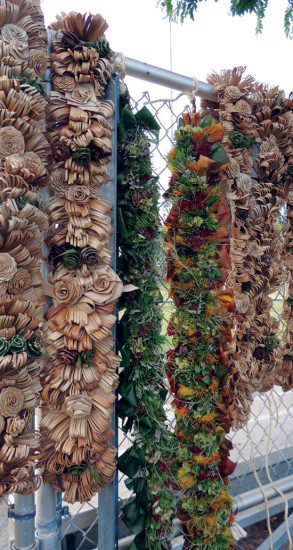 As elegant as the pā‘ū skirts are, perhaps the most impressive part of the outfit is the incredible artistry of the headpieces, lei, and horse lei that captivate people’s attention when they watch pā‘ū riders.
As elegant as the pā‘ū skirts are, perhaps the most impressive part of the outfit is the incredible artistry of the headpieces, lei, and horse lei that captivate people’s attention when they watch pā‘ū riders.
The pā‘ū queen and each island princess are responsible for designing, gathering, and creating the lei and headpieces used in their unit.
“When we went through the training, one of the sounding directives from Aunty Barbara was to use what is in your ahupua‘a,” says Anna, “To be resourceful.”
Anna grew up in Hilo and chose flowers that represented her district.
“I really wanted to honor the land of our birth. I went with the traditional foliage on our land,” says Anna.
She says the women’s lei were fashioned with multi-hued lehua blossoms from deep crimson, bright and pale reds, vibrant salmon to pale rust orange and golden lehua mamo. Additional foliage included liko lehua, maroon and chartreuse ‘a‘ali‘i, green palapalai and wāwae‘iole fern, silver ‘umi‘umi-o-Dole, gold and green moa, and green and golden yellow ti leaves.
“It was very symbolic of where I grew up in Hilo,” explains Anna.
“My crown was a feather lei. It was one that my daughter made for me. When we think of the ali‘i of old they had feather standards that were symbols of their royal status, so I utilized the yellow feather lei.
“For the women’s leis we used fresh flora while the men all had lauhala and coconut frond leis for themselves and their horses.”
Creating all the lei for both riders and horses was a group effort that took countless hours says Anna. Gathering and preparing the coconut fronds, and various shades of brown, tan, and crimson lauhala for the lei making was a major undertaking.
In the weeks leading up to the parade they put the word out that they needed help gathering material for the lei. Word reached a group of lauhala weavers and those weavers went ahead and started making rosettes. The family organized a lei preparation day shortly before the parade and, “When I showed up at the cottage to prepare the leis, we had three dozen weavers show up.”
Even with so many willing hands she says, “One lei alone took a whole day to gather and prepare and strip the lauhala and then to soften it. Then we had to hand stitch the lauhala and coconut fronds and sew the leis together. That’s just the lauhala and coconut lei.”
After putting so much effort into the men’s horses’ lei, Anna says her family decided to keep them after the parade. They are on public display at the cultural center at the Mauna Lani Bay Hotel and Bungalows in the Mauna Lani Resort.
Gathering the materials for the women’s floral lei was even more of an adventure.
“With the fresh floral leis, there were more than a dozen of us that went out to gather just the lehua,” says Anna. “A friend with a ranch in Kohala opened his property to us to let us gather flowers. “We spent an entire day riding across these storied lands and would stop to oli (chant) and pule (pray) and to ask permission to be there in safety. It wasn’t just going out and gathering. It was going out and being in the amazing elements of Kohala as you called out and asked to be there. It was a chicken skin moment in time.”
Anna also recalls with gratitude another instance when someone opened their property to them so they could gather ti leaves for their lei.
“We were up in Kohala for the June 11 King Kamehameha Day parade and explained to someone that we couldn’t stay because we had to go down to Kona to pick ti leaves for our own lei in the upcoming Kona parade.”
This person said, ”You need ti leaf? Come, I have ti leaf for you.” Anna says, “There were at least eight of us picking ti leaves. It took all eight of us an hour to gather the amount of ti leaves we needed for all of our leis.”
It took more than 100 people just for the queen’s unit in last year’s Kona parade.
“I have to tip my hat to all the men and women who helped to mentor me to become queen of this parade.” Looking back on her experience last year, Anna says, “It was all the preparation and all of the people that opened their hearts and their minds and talents to us that was a priceless gift beyond words.” ❖
Photos courtesy Sophie Greeno.
Contact writer Denise Laitinen: wahineokekai@yahoo.com
